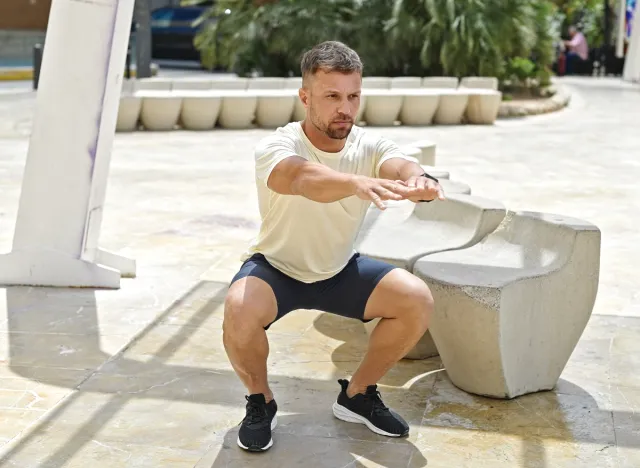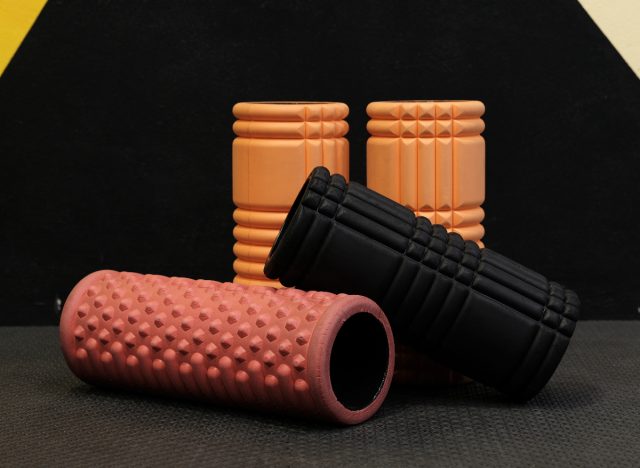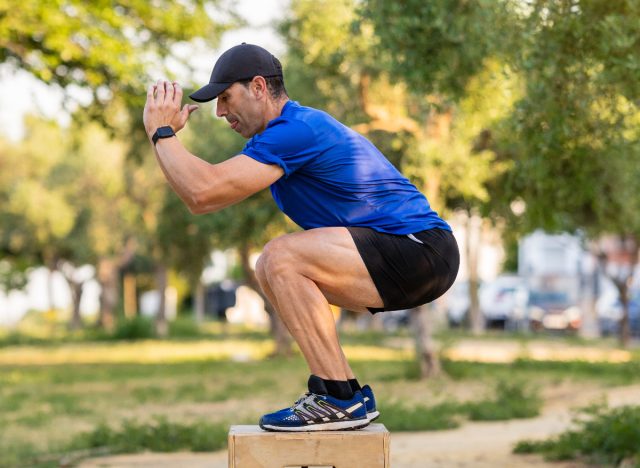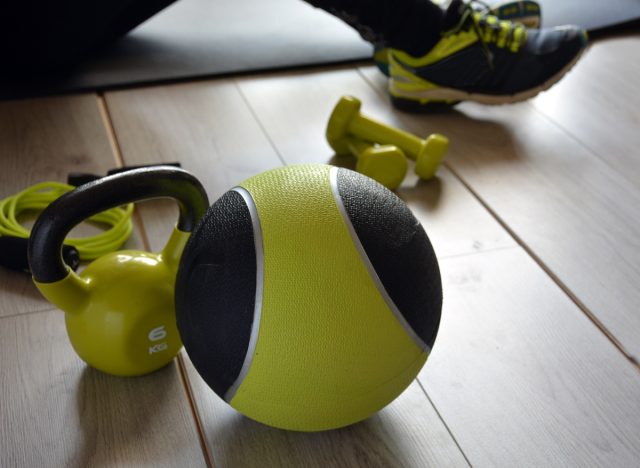I'm a Trainer & Give These 10 Strength Training Tips to All Men Over 40

Reaching your 40s doesn't mean slowing down—it's a prime time to focus on getting stronger and feeling better. As a coach, I often see men in this age group neglect strength training or stick to outdated methods that don't serve their current goals or lifestyle. However, building and maintaining muscle is crucial for looking fit and overall health, mobility, and longevity. So, I've rounded up seven of the best strength training tips for men over 40 to maximize your workout results.
Strength training for men over 40 is about working smarter, not harder. While lifting principles—challenging your muscles and focusing on technique—are the same, the approach should consider recovery, sustainability, and functional movement. By tailoring your workouts to your needs and abilities, you're setting yourself up for better strength, vitality, and performance.
This article covers my top seven strength training tips that every man over 40 should know. From making the most of your workout time to prioritizing recovery and training power, these tips will help you stay fit, build muscle, and avoid burnout. Let's maximize your results and keep your body strong, capable, and healthy.
Tip #1: Make Your Workouts Work for You

For men over 40, finding time-efficient and effective workouts is critical. Full-body workouts allow you to target all major muscle groups without committing to several weekly sessions. Compound exercises—like squats, deadlifts, rows, and presses—activate multiple muscles simultaneously, which boosts calorie burn and maximizes your time in the gym.
Prioritizing compound movements over isolated ones can lead to more balanced muscle growth and improved functional strength, helping you perform better in workouts and daily activities. By strategically adding short intervals for cardio or using supersets, you can make each session as efficient and results-driven as possible.
Pro Tips:
- Superset for Efficiency: Pair exercises for opposing muscle groups, such as bench presses and rows or bicep curls and tricep extensions. Supersets reduce rest time, keep your heart rate up, and reduce total workout time.
- Add Finisher Intervals: Consider ending workouts with quick finishers—like kettlebell swings, sled pushes, or battle ropes for one to two minutes. These high-intensity intervals boost calorie burn, improve cardiovascular health, and enhance metabolism.
- Plan Based on Your Week: Do full-body workouts daily if you're limited to three days. With four days, consider an upper/lower body or push/pull split to add more variety.
Tip #2: Prioritize Consistency Above All

Consistency is foundational to a successful strength training program, especially as you age. Building muscle, strength, and fitness requires ongoing, progressive overload to see improvements.
For men over 40, maintaining consistency while accommodating slower recovery rates is essential. A steady routine and a sustainable pace are better than sporadic, intense workouts. Progress may sometimes feel slower, but even small, incremental gains add up over months and years.
Pro Tips:
- Schedule Your Workouts: Treat your workouts like essential appointments. Set specific days and times each week and commit to them.
- Track Your Progress: Use a log to record weights, reps, and how you feel each workout. Seeing progress on paper can motivate, even when it isn't apparent.
- Set Small, Attainable Goals: Instead of focusing on drastic gains, aim for achievable benchmarks, like adding five pounds to a monthly lift or doing one extra set than the previous week.
Tip #3: Own Your Recovery

Recovery becomes even more crucial as we age. After 40, muscles need more time to repair, and neglecting recovery can lead to injury and burnout. Beyond just rest days, proactive recovery techniques—such as adequate sleep, nutrition, and active recovery—are vital for keeping energy levels high and ensuring you get the most from each workout. The more you prioritize recovery, the better your body can adapt to strength training.
Pro Tips:
- Prioritize Sleep: Aim for seven to nine hours of quality sleep nightly, as most muscle repair happens during rest. If you struggle with sleep, create a routine to wind down at night.
- Eat Enough Protein: Protein is essential for muscle repair and growth. Aim for 1.0-1.2 grams of protein per pound of body weight daily, spread evenly across meals.
- Stretch or Foam Roll: Regular stretching and foam rolling after workouts improve circulation, reduce muscle tightness, and keep you mobile. Spend five to 10 minutes post-workout on key areas like hips, shoulders, and lower back.
Tip #4: Focus on Building Muscle

Muscle building does more than enhance your physique; it preserves your metabolism, maintains joint stability, and supports bone health. Muscle mass naturally declines as we age, but regular strength training can combat this. Building muscle protects against injuries, improves balance, and reduces the risk of chronic conditions.
To progress continuously, focus on progressive overload, whether by increasing weight or reps or adjusting tempo over time.
Pro Tips:
- Increase Weight Gradually: On major lifts, aim to increase weights by about 5% to 10% every two to three weeks to keep challenging your muscles without risking injury.
- Use Tempo Training: Slow down reps (e.g., three seconds down, one second up) to increase time under tension, which activates more muscle fibers and supports growth.
- Focus on Form: Quality over quantity, especially with heavier weights. Ensure proper form for each lift to prevent injury and ensure muscles—not joints—are doing the work.
Tip #5: Master the Basics First

Mastering the basics lays a strong foundation for all other exercises and activities. Basic compound movements—like squats, deadlifts, lunges, rows, and presses—target large muscle groups and build functional strength that supports everyday tasks.
Before advancing to complex exercises, ensure proper form and a strong core, which helps stabilize and protect the body during intense movements. After mastering the basics, adding variety with isolation or more advanced moves becomes safer and more effective.
Pro Tips:
- Learn to Brace Your Core: Proper bracing stabilizes the spine and protects the lower back. Before each rep, take a deep breath, engage your core as if bracing for a punch, and maintain that tension.
- Work on Hip Mobility: Good hip mobility allows for safer, deeper squats and deadlifts. To stay limber, include stretches like hip flexor lunges or frog stretches.
- Start with Bodyweight: Perfect your form with bodyweight versions before adding weights—for instance, practice bodyweight squats or lunges before progressing to loaded versions.
Tip #6: Don't Deny the Power of Power Training

Power training maintains muscle responsiveness. This quality is essential for preventing injuries and ensuring balance and stability. Movements like jumps, medicine ball throws, and sled sprints train fast-twitch muscle fibers, which tend to decline with age. Power training is more about speed and control than lifting heavy, so start with lighter weights and focus on explosive movements.
Incorporating power into your routine helps maintain athleticism and supports overall strength.
Pro Tips:
- Start Light: Begin with lighter weights to refine the explosive movement, then increase resistance gradually.
- Use Plyometrics for Power: Exercises like box jumps or jump squats build lower-body power and coordination. Keep reps low (three to five per set) to reduce joint impact and emphasize quality.
- Limit Power Training to Twice a Week: Since power moves can strain joints and the nervous system, limit them to one or two days a week to avoid overuse.
Tip #7: Prioritize Multi-Planar Movements

Life happens in multiple directions, so training only in one plane limits your overall strength and mobility. Multi-planar exercises involving different movement directions help improve balance, flexibility, and core stability. They also make your body more resilient to injury in day-to-day activities by challenging muscles that don't get as much focus in linear exercises.
Pro Tips:
- Incorporate Rotational Movements: Moves like Russian twists, wood chops, or rotational med ball throws build core strength and rotational power, which are crucial for daily functional movements.
- Try Lateral Movements: Lateral lunges, side shuffles, and step-outs strengthen stabilizing muscles around the hips and adductors, improving hip stability and balance.
- Add Directional Changes: Exercises requiring direction changes, like agility ladder drills or cone shuffles, enhance balance, coordination, and reaction time, helping keep you agile and less injury-prone.









